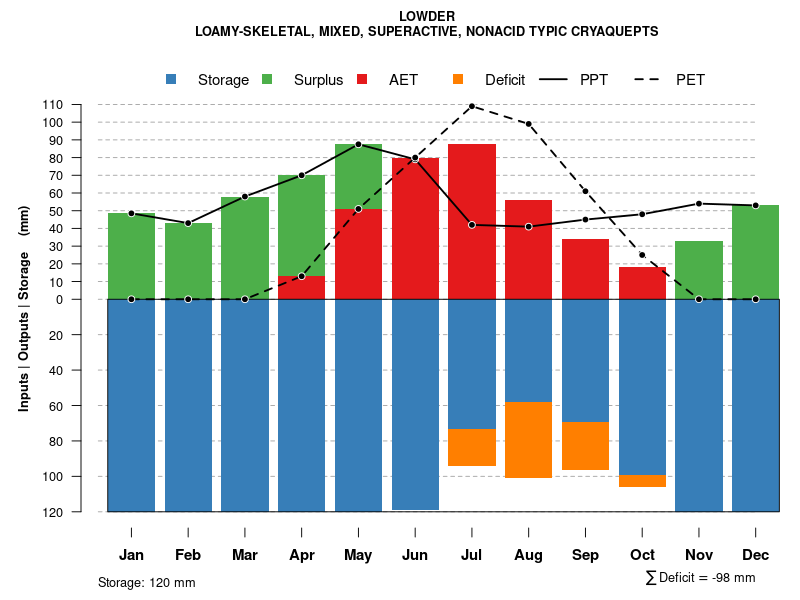| Como-Garlet-Lowder families, complex, glacial moraines | 341S | 352 | 2024042 | 25y5p | id758 | 1998 | 1:24000 |
Waldbillig-Bata-Lowder, frequently flooded families, complex, cirque basins | 257Sa | 23126 | 149348 | 50dp | mt605 | 2007 | 1:24000 |
Como-Elkner-Lowder, frequently flooded families, complex, glacial moraines | 348S | 22147 | 149347 | 50dn | mt605 | 2007 | 1:24000 |
Upsata-Bata-Lowder, frequently flooded families, complex, cirque basins | 258Sa | 20139 | 149353 | 50dv | mt605 | 2007 | 1:24000 |
Rubycreek-Bata-Lowder, frequently flooded families, complex, trough bottoms | 237Ua | 10927 | 149116 | 5056 | mt605 | 2007 | 1:24000 |
Littlesalmon-Como-Lowder, frequently flooded families, complex, trough bottoms | 238Ua | 8737 | 149342 | 50dh | mt605 | 2007 | 1:24000 |
Como-Lowder, frequently flooded-Lilylake, frequently flooded families, complex, trough bottoms | 238U | 5903 | 636486 | pc9t | mt605 | 2007 | 1:24000 |
Wichup, rarely flooded-Mooseflat, rarely flooded-Lowder, frequently flooded families, complex, valley bottoms | 648G | 5544 | 148737 | 4zrz | mt605 | 2007 | 1:24000 |
Como-Garlet-Lowder families, complex, glacial moraines | 341S | 4692 | 148577 | 4zlt | mt605 | 2007 | 1:24000 |
Garlet-Worock-Lowder, frequently flooded families, complex, cirque basins | 257S | 3998 | 148567 | 4zlh | mt605 | 2007 | 1:24000 |
Como-Garlet-Lowder, frequently flooded families, complex, trough bottoms | 231U | 3808 | 636670 | pchr | mt605 | 2007 | 1:24000 |
Bata-Rubycreek-Lowder, frequently flooded families, complex, alluvial-colluvial deposits basins | 613Ua | 3507 | 640647 | phn1 | mt605 | 2007 | 1:24000 |
Lowder-Como families, complex, glacial moraines | 348U | 3206 | 149041 | 502s | mt605 | 2007 | 1:24000 |
Bata-Littlesalmon-Lowder, frequently flooded families, complex, landslide deposits | 708Ua | 3123 | 637476 | pdbr | mt605 | 2007 | 1:24000 |
Upsata-Como-Lowder, frequently flooded families, complex, valley bottoms | 648Ua | 2376 | 628364 | p2vt | mt605 | 2007 | 1:24000 |
Garlet-Worock-Lowder, frequently flooded families, complex, landslide deposits | 707S | 2243 | 149339 | 50dd | mt605 | 2007 | 1:24000 |
Littlesalmon-Como-Lowder, frequently flooded families, complex, alluvial-colluvial deposits | 618Ua | 2205 | 640649 | phn3 | mt605 | 2007 | 1:24000 |
Helmville-Lowder, frequently flooded-Whitore families, complex, valley bottoms | 644U | 1753 | 628316 | p2t8 | mt605 | 2007 | 1:24000 |
Como-Lowder, frequently flooded-Worock families, complex, landslide deposits | 708S | 1399 | 149102 | 504r | mt605 | 2007 | 1:24000 |
Garlet-Worock-Lowder, frequently flooded families, complex, alluvial-colluvial deposits | 617S | 985 | 149335 | 50d8 | mt605 | 2007 | 1:24000 |
Como-Elvick-Lowder, frequently flooded families, complex, alluvial-colluvial deposits | 618U | 629 | 149071 | 503r | mt605 | 2007 | 1:24000 |
Lowder, frequently flooded-Lilylake, frequently flooded-Como families, complex, valley bottoms | 648U | 627 | 148741 | 4zs3 | mt605 | 2007 | 1:24000 |
Garlet-Worock-Lowder families, complex, alluvial-colluvial deposits | 617S | 199 | 1531224 | 1ndcb | mt610 | 2005 | 1:24000 |
Wichup-Mooseflat-Lowder families, complex, valley bottoms | 648G | 198 | 1531211 | 1ndbx | mt610 | 2005 | 1:24000 |
Rubycreek-Bata-Lowder families, complex, trough bottoms | 237Ua | 84 | 1531222 | 1ndc8 | mt610 | 2005 | 1:24000 |
Upsata-Como-Lowder families, complex, valley bottoms | 648Ua | 29 | 1531215 | 1ndc1 | mt610 | 2005 | 1:24000 |
Lowder-Lilylake-Como families, complex, valley bottoms | 648U | 28 | 1531239 | 1ndct | mt610 | 2005 | 1:24000 |
Como-Garlet-Lowder families, complex, glacial moraines | 341S | 159 | 2597697 | 4zlt | mt612 | 2011 | 1:24000 |
Garlet-Worock-Lowder, frequently flooded families, complex, landslide deposits | 707S | 138 | 2597774 | 50dd | mt612 | 2011 | 1:24000 |
Como-Lowder, frequently flooded-Lilylake, frequently flooded families, complex, trough bottoms | 238U | 137 | 2597783 | pc9t | mt612 | 2011 | 1:24000 |
Lowder, frequently flooded-Lilylake, frequently flooded-Como families, complex, valley bottoms | 648U | 45 | 2597729 | 4zs3 | mt612 | 2011 | 1:24000 |
Lowder-Elvick very cobbly loams, 2 to 15 percent slopes, very bouldery | 2501D | 324 | 150943 | 5224 | mt627 | 1998 | 1:24000 |
Elvick-Lowder complex, 8 to 25 percent slopes, very bouldery | 2472E | 284 | 150933 | 521t | mt627 | 1998 | 1:24000 |
Branham-Lowder loams, 0 to 8 percent slopes | 1851D | 258 | 150743 | 51vp | mt627 | 1998 | 1:24000 |
Branham-Lowder loams, 8 to 25 percent slopes | 1851E | 165 | 150744 | 51vq | mt627 | 1998 | 1:24000 |
Finn-Lowder-Dunkleber families, complex, stream terraces and flood plains | 64UJ1 | 4404 | 149475 | 50js | mt635 | 2006 | 1:24000 |
Finn-Lowder families, complex, moderately steep young moraines | 21UJ1 | 3701 | 149409 | 50gn | mt635 | 2006 | 1:24000 |
Waldbillig-Cowood-Lowder families, complex, steep glaciated mountain slopes and ridges | 15ND3 | 3581 | 149382 | 50fs | mt635 | 2006 | 1:24000 |
Bata-Lowder-Elve families, complex, moderately steep young moraines | 21UF2 | 2151 | 149405 | 50gj | mt635 | 2006 | 1:24000 |
Finn-Lowder families, complex, moderately steep trough bottoms | 37UJ1 | 743 | 149438 | 50hl | mt635 | 2006 | 1:24000 |
Como-Garlet-Lowder families, complex, trough bottoms | 315 | 631 | 1710128 | 1vdjf | mt636 | 1983 | 1:24000 |
Finn-Lowder-Dunkleber families, complex, stream terraces and flood plains | 260 | 76 | 1703440 | 1v5kp | mt636 | 1983 | 1:24000 |
Como-Garlet-Lowder families, complex, glacial moraines | 275 | 42 | 1710132 | 1vdjk | mt636 | 1983 | 1:24000 |
Helmville-Lowder-Whitore families, complex, valley bottoms | 304 | 25 | 1710161 | 1vdkh | mt636 | 1983 | 1:24000 |









